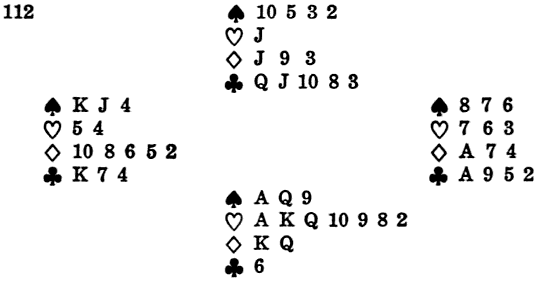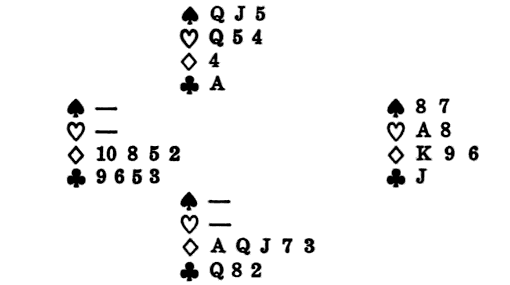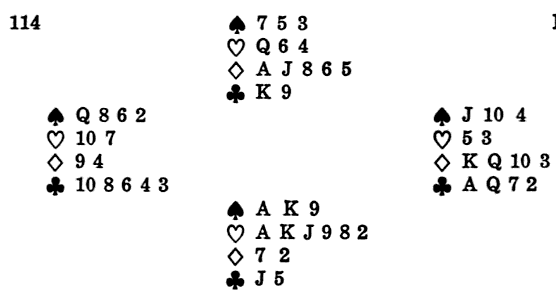This article is concerned with one of the most important and least analysed forms of defensive play, the attack on entries before declarer can use them.
Creating Entry Trouble
To set the mood, we will begin with a fairly spectacular example:

North opened 1 and South, after discovering that his partner held two aces, forced the bidding up to 6
and South, after discovering that his partner held two aces, forced the bidding up to 6 . West led
. West led  7 and East won the first trick with jack. He returned a diamond up to weakness, whereupon South drew trumps, led a heart to the ace and played East for
7 and East won the first trick with jack. He returned a diamond up to weakness, whereupon South drew trumps, led a heart to the ace and played East for  K, making twelve tricks.
K, making twelve tricks.
East should have foreseen this danger and should have returned a heart at trick 2 to cut liaison. That would have held South to two heart tricks in all and he would have had to lose a spade or a diamond.
Taking Advantage of a Blocked Suit
The point of the defence on the last hand was that East had to return a heart while West had a trump with which to interrupt the run of the suit. More often, the object of such play is to attack an entry before declarer has had an opportunity to unblock one of his suits.

South opened with a forcing bid and went to 4 on his own. West led
on his own. West led  5, and East won with ace, and South dropped the king. When East returned a spade South went up with the ace, cashed
5, and East won with ace, and South dropped the king. When East returned a spade South went up with the ace, cashed  Q, entered dummy with
Q, entered dummy with  J and discarded a loser on
J and discarded a loser on  J. This gave him ten tricks.
J. This gave him ten tricks.
If West’s  5 was to be read as fourth best, East, by deducting 5 from 11, could have worked out that South had two diamonds higher than the 5 (Rule of 11). These were obviously
5 was to be read as fourth best, East, by deducting 5 from 11, could have worked out that South had two diamonds higher than the 5 (Rule of 11). These were obviously  K-Q, so the right defence was to return a trump at trick 2, killing dummies only entry before
K-Q, so the right defence was to return a trump at trick 2, killing dummies only entry before  J could be enjoyed. A dry honor combination such as South’s
J could be enjoyed. A dry honor combination such as South’s  K-Q is the usual sign that declarer may have entry trouble. The defenders recognised this and cooperated to fine effect on the next deal from a match between England and Eire.
K-Q is the usual sign that declarer may have entry trouble. The defenders recognised this and cooperated to fine effect on the next deal from a match between England and Eire.

The Irish pair reached 3 NT, which looks doubtful on the North-South hands but is not easy to defeat. Declarer won the club lead in dummy and pushed spades, East won the second round. East made a good switch at this point, leading a low heart in preference to a club. West won with  K and played
K and played  J, which held the trick. The position was now:
J, which held the trick. The position was now:

A club is the obvious play, but West looked more deeply into the position. He saw that if declarer had  A-Q, together with a club trick, as seemed likely from East’s failure to continue the suit, he would have enough tricks for game if a club were played now. Better defence was a diamond, while the
A-Q, together with a club trick, as seemed likely from East’s failure to continue the suit, he would have enough tricks for game if a club were played now. Better defence was a diamond, while the  A was still in the way. So West led
A was still in the way. So West led  8 and East correctly withheld his king. Declarer made
8 and East correctly withheld his king. Declarer made  Q and
Q and  A but had to concede two hearts at the finish.
A but had to concede two hearts at the finish.
An Attack from Long Range
This is another ordinary seeming hand on which the defence’s opportunity to create entry trouble is seldom noticed:

West opened  4 against 4
4 against 4 and East won the first two tricks. The presence of a long suit in dummy generally suggests the need to attack entries, but the lead of a spade up to dummy’s weakness seemed obvious and East switched to
and East won the first two tricks. The presence of a long suit in dummy generally suggests the need to attack entries, but the lead of a spade up to dummy’s weakness seemed obvious and East switched to  J. South won with ace and ducked a round of diamonds; East played a second spade and the king won. Now South laid down
J. South won with ace and ducked a round of diamonds; East played a second spade and the king won. Now South laid down  A, led a diamond to the ace and ruffed a diamond with
A, led a diamond to the ace and ruffed a diamond with  J: when trumps broke 2-2 he was able to set up the fifth diamond. It was not an obvious defence by any means, but East should have returned a trump at trick 3. A count of entries would have shown him that dummy’s diamonds could be killed, so there was no hurry to attack spades, South would have won the trump lead and ducked a diamond; then East plays a second trump; this is the killer, for it makes South use an entry to dummy before he has begun to ruff diamonds.
J: when trumps broke 2-2 he was able to set up the fifth diamond. It was not an obvious defence by any means, but East should have returned a trump at trick 3. A count of entries would have shown him that dummy’s diamonds could be killed, so there was no hurry to attack spades, South would have won the trump lead and ducked a diamond; then East plays a second trump; this is the killer, for it makes South use an entry to dummy before he has begun to ruff diamonds.
Esta entrada también está disponible en: Spanish

